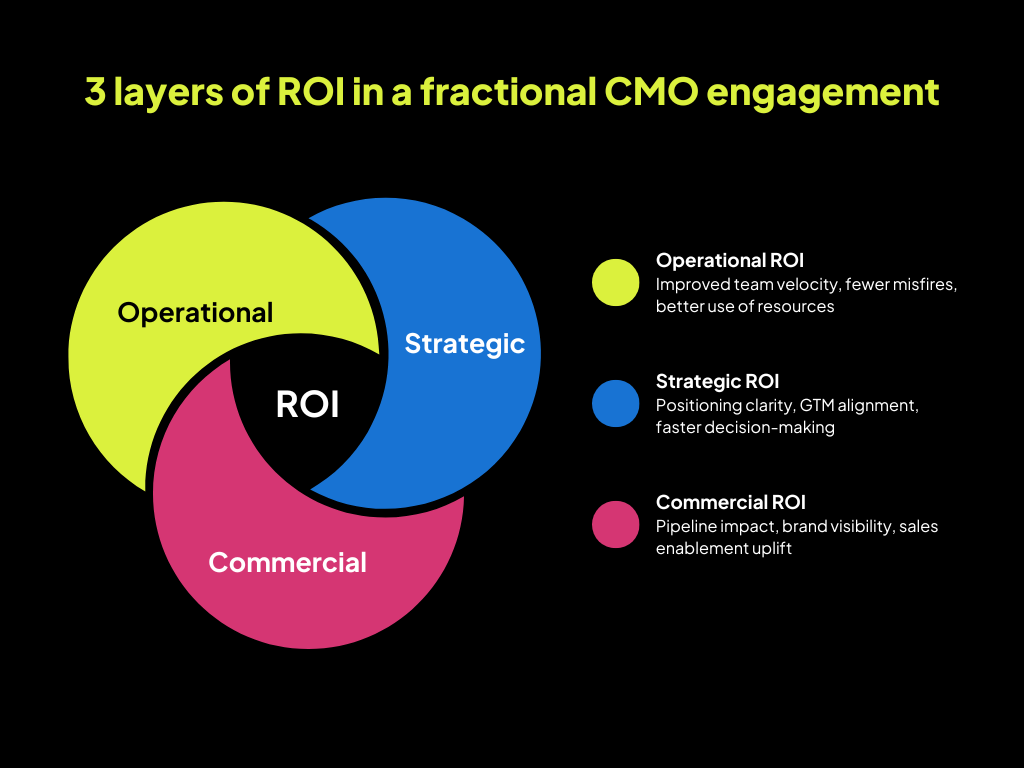Hiring a Fractional CMO is a strategic investment, but without the right metrics, it’s hard to quantify the value. This article helps B2B leaders understand how to evaluate success beyond the surface.
Why ROI feels hard to measure in strategic marketing leadership?
The value a Fractional CMO brings isn’t always immediate or easily captured in spreadsheets. Unlike performance marketers or sales teams with tight attribution loops, strategic marketing leaders operate across a broader scope: brand consistency, GTM clarity, pipeline velocity, and org-wide alignment.
This ambiguity is exactly what stalls decisions. “How do we know it’s working?” becomes a recurring question in board meetings.
But that doesn’t mean ROI is unmeasurable. It just means we need to widen our lens—and sharpen what we’re looking for.
What does ROI actually mean in a fractional CMO engagement?
Return on investment in this context isn’t just about more leads or lower CAC. It’s about enabling the marketing function to scale smarter, with better messaging, stronger targeting, and clearer prioritization.
Here’s how we define ROI for Tailwind’s Fractional CMO partnerships:
- Marketing’s influence on pipeline velocity and revenue conversations
- Strategic clarity: a leadership team aligned on positioning, GTM, and roadmap
- Operational efficiency: fewer ad-hoc campaigns, more consistent execution
- Team productivity: less rework, clearer roles, and better use of in-house resources
- Faster decision-making on martech, vendors, and priorities
How to track and report ROI quarterly
Evaluating ROI starts with building the right framework. We recommend a quarterly model anchored in three pillars:
1. KPIs that link to business goals
- Pipeline contribution (SQLs, opportunities)
- Time-to-execute for key GTM initiatives
- Brand lift (qualitative indicators, CTR changes on branded queries)
2. Qualitative signals from leadership & sales
- “Our story finally lands in sales conversations.”
- “Leadership has stopped debating positioning every quarter.”
- “We’re not chasing every shiny object anymore.”
3. Clear before/after deltas
- From reactive to roadmap-led
- From scattered campaigns to a clear content engine
- From siloed sales and marketing to shared priorities
What success feels like
Not everything worth measuring has a tidy metric. And that’s okay.
Some of the most valuable signals of success sound like this:
“The sales deck finally makes sense to everyone.”
“We’re being invited to speak at events that used to ignore us.”
“We’re shipping fewer campaigns—but they land harder.”
That’s ROI, too.
Aligning ROI with funnel stage: when to have this conversation
This article is best used in the BOFU stage—when stakeholders are already considering a Fractional CMO engagement but need concrete indicators to validate the investment.
If your leadership is stuck on the question, “Is this really worth it?”, this framework helps them move forward with confidence.
Pro tips for B2B brands making the case internally
- Benchmark where you are now: team velocity, positioning clarity, campaign outcomes
- Define your success metrics up front, and revisit them every 90 days
- Don’t rely on vanity metrics alone. Tie qualitative improvements back to business goals
- Use case studies and real-world deltas (before/after) to build internal buy-in
Ready to track what matters?
If you’re exploring a Fractional CMO engagement, make sure your leadership is aligned not just on what success should look like, but how you’ll know when you’re getting there.









